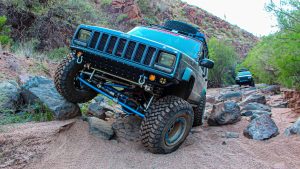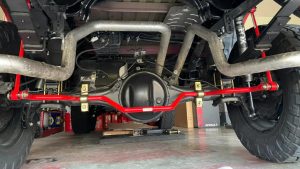When it comes to off-road performance, few suspension components spark as much debate as the stabilizer bar, also known as the sway bar or anti-roll bar. Designed to reduce body roll during cornering, the stabilizer bar plays a critical role in vehicle handling — but in off-road environments, where flexibility (articulation) is king, its presence can become a double-edged sword. So how do off-road enthusiasts strike the perfect balance between on-road stability and off-road articulation?
This article explores the function of stabilizer bars in off-road vehicles, their advantages and limitations, and how to modify or upgrade them to suit rugged terrain without compromising safety and control.

What Does a Stabilizer Bar Do?
The stabilizer bar connects the left and right wheels of a vehicle through the suspension. Its main purpose is to resist body roll during sharp turns by transferring force from one side of the vehicle to the other. This is especially useful during high-speed driving and cornering on paved roads.
However, off-roading introduces a different dynamic — instead of cornering at high speeds, the focus is on maneuvering over uneven terrain where each wheel may move independently.
Stability vs. Articulation: The Off-Road Dilemma
| Characteristic | Stability (On-Road) | Articulation (Off-Road) |
|---|---|---|
| Purpose | Prevent body roll | Maximize wheel travel on uneven ground |
| Benefits | Better handling, reduced sway | Improved traction, better obstacle control |
| Stabilizer Bar Impact | Positive (increases control) | Negative (limits suspension flexibility) |
| Ideal Setup | Stiff or OEM stabilizer bar | Disconnected or flexible sway bar |
In off-road scenarios, a connected stabilizer bar can hinder wheel movement, reducing traction. But completely removing it can make on-road handling dangerously loose. That’s why finding a balance is essential.
When a Stabilizer Bar Becomes a Limitation
In extreme off-roading — rock crawling, trail climbing, or mudding — full suspension articulation allows each wheel to react independently to terrain changes. A rigid stabilizer bar resists this motion, effectively limiting your wheel travel and causing:
-
Loss of traction on uneven surfaces.
-
Wheel lift, making the vehicle unstable.
-
Reduced ride comfort due to restricted suspension movement.
Solutions: How Off-Roaders Adapt Stabilizer Bars
-
Quick Disconnect Kits
-
These allow you to easily disconnect the sway bar before hitting the trail and reconnect it for the drive home.
-
Ideal for dual-purpose vehicles.
-
-
Sway Bar Disconnect Systems (Electronic or Manual)
-
Found on vehicles like the Jeep Wrangler Rubicon.
-
Allows real-time sway bar disconnection from inside the cabin.
-
-
Aftermarket Adjustable Sway Bars
-
Tuned for moderate articulation and improved on-road handling.
-
Offers a middle ground for mixed-use drivers.
-
-
Removable Stabilizer Bars
-
Used in extreme off-road builds.
-
These bars are entirely removed for competition use and only installed when needed.
-
Pros and Cons of Disconnecting Stabilizer Bars
| Aspect | Connected | Disconnected |
|---|---|---|
| On-Road Handling | Excellent | Poor (increased body roll) |
| Off-Road Articulation | Limited | Maximum |
| Safety | High (for daily driving) | Risky if forgotten on highways |
| Traction on Uneven Terrain | Low | High |
| Setup Time | None | Requires preparation or kit |
When Should You Disconnect or Upgrade Your Stabilizer Bar?
-
Mild Off-Roading or Overlanding: Keep sway bar connected or use an adjustable one.
-
Weekend Trails: Use quick disconnect kits.
-
Rock Crawling or Mud Runs: Fully disconnect or use electronic disconnects.
-
Daily Driving with Occasional Off-Road Use: Consider an adjustable sway bar setup.
Top Tips for Off-Road Stabilizer Bar Optimization

-
Install Quick Disconnects – Simple and effective solution for mixed-use vehicles.
-
Check Bushings and Links – Ensure these components are in good shape to maintain proper function when connected.
-
Balance Spring and Shock Setup – A properly tuned suspension works in harmony with or without the sway bar.
-
Practice Safe Reconnection – Never drive on highways with the sway bar disconnected.
-
Upgrade for Flexibility – Choose sway bars made from torsionally tuned materials for better articulation.
Conclusion: Striking the Right Balance
Stabilizer bars are essential for on-road safety but can be a hindrance in off-road situations that demand maximum suspension articulation. The key is to evaluate your driving habits and terrain. Whether you’re commuting during the week and hitting trails on weekends, or you’ve built a dedicated off-roader, the right stabilizer bar setup can dramatically enhance your driving experience.
For maximum performance and reliability, consider upgrading your stabilizer components.
Buy Stabilizer & Components online to ensure your off-road rig is ready for any terrain — without sacrificing safety and control.